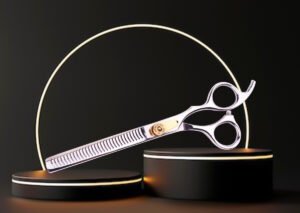As a professional hairstylist, your scissors are one of your most valuable tools. They’re the key to delivering sharp, precise cuts and achieving the looks your clients desire. To keep them in top condition, regular maintenance is essential. A well-maintained pair of scissors not only ensures smooth, accurate cuts but also extends the life of the blades, saving you money in the long run.
In this blog post, we’ll dive into the essentials of a hair cutting scissor maintenance kit and why each component is important for the longevity and performance of your scissors.
Why Scissor Maintenance Matters
Before we get into the specifics of a maintenance kit, it’s important to understand why regular upkeep is crucial:
- Sharp, well-maintained scissors make clean cuts, ensuring that hair doesn’t get tugged or split.
- Properly balanced and tensioned scissors reduce hand strain and make cutting easier.
- Regular maintenance prevents wear and tear, keeping your scissors in good working order for years.
- Clean scissors reduce the risk of infections and ensure a professional standard of care.
What Should Be in Your Hair Cutting Scissor Maintenance Kit?
A good maintenance kit is more than just a few cleaning tools; it’s a comprehensive set designed to keep your scissors in optimal condition. Here’s what you need:
1. Cleaning Cloth
A microfiber cleaning cloth is an essential part of any maintenance kit. It’s used to wipe down the blades after each use, removing hair, product residue, and any moisture that could lead to rust or corrosion. Regular cleaning prevents buildup that can dull the blades and affect cutting performance.
After each haircut, gently wipe the blades with the cloth, paying special attention to the area near the pivot screw where debris often accumulates.
2. Scissor Oil
Scissor oil is a must-have to keep your blades smooth and free from rust. A few drops of oil applied regularly will reduce friction between the blades, ensuring they move smoothly and reducing wear over time.
Place a drop of oil at the pivot point and along the inside of the blades. Open and close the scissors a few times to distribute the oil evenly.
3. Tension Adjustment Tool
The tension of your scissors determines how easily they open and close. A tension adjustment tool, usually a small screwdriver or a specialized key, allows you to fine-tune the tension to suit your cutting style and the thickness of the hair you’re working with.
Test the tension regularly using the drop test, and adjust as necessary to keep your scissors in perfect working order.
4. Sharpening Stone or Honing Tool
While sharpening should generally be left to professionals, having a small sharpening stone or honing tool in your kit can be useful for touch-ups between professional services. This is especially helpful if you notice a slight dullness in the blades but aren’t ready to send them out for sharpening.
Gently run the blades along the stone or honing tool, following the angle of the edge. Use sparingly and with caution to avoid over-sharpening or damaging the blades.
5. Alcohol Wipes
Alcohol wipes are perfect for sanitizing your scissors between clients. This is essential not just for maintaining the cleanliness of your tools but also for adhering to health and safety standards in your salon.
Wipe down the entire surface of the scissors, including the handles, after each use to eliminate any bacteria or germs.
6. Blade Cover or Sheath
A blade cover or sheath is important for protecting your scissors when not in use. It prevents accidental damage to the blades and keeps them clean and sharp.
Always store your scissors in a protective cover when they are not in use to avoid nicks and scratches on the blades.
7. Case or Pouch
A dedicated case or pouch for your maintenance kit is essential for keeping all your tools organized and readily accessible. It also makes it easy to take your maintenance kit with you if you work in multiple locations or need to bring it along for on-the-go maintenance.
Regular maintenance is key to keeping your scissors in top condition. Here’s a simple routine you can follow:
- After each use, wipe down the blades with a microfiber cloth and check the tension. If necessary, apply a drop of oil to the pivot point.
- At least once a week, sanitize your scissors with alcohol wipes and check for any signs of dullness or damage. Adjust the tension as needed.
- Inspect your scissors for any significant wear and perform light honing if necessary. Ensure that the pivot screw is secure and that the scissors are operating smoothly.
Final Thoughts
Investing in a quality hair cutting scissor maintenance kit is one of the best things you can do for your professional tools. By regularly cleaning, oiling, and adjusting your scissors, you’ll ensure they stay sharp, comfortable, and precise—making your job easier and your clients happier. Remember, a little maintenance goes a long way in protecting your investment and maintaining the high standards of your work. Whether you’re a seasoned stylist or just starting out, having the right maintenance tools on hand is essential for success.



